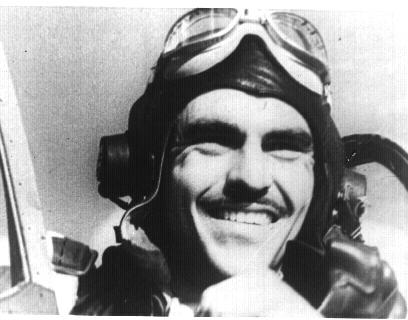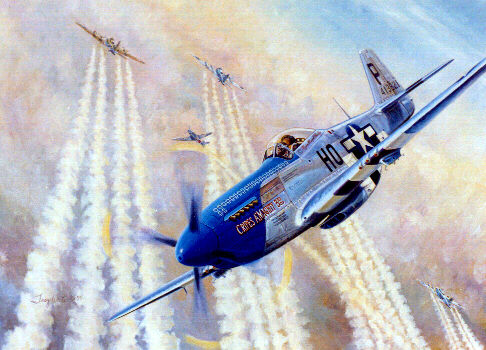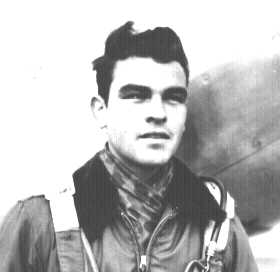| Synopsis of George Preddy Top Mustang Ace by Joe Noah |
|
|---|---|
| Home Page | Airmen Index |
 |
|
| George Preddy was on his way to becoming the leading ace in Europe
when tragedy struck. General John C. Meyer, who was the fourth ranking
American ace in the ETO (European Theater of Operations) and Preddy's squadron commander for
more than a year, wrote: "I have never met a man of... such intense
desire to excel.... George Preddy was the
complete fighter pilot."
Preddy grew up in Greensboro, North Carolina. Before the war, he was a barnstormer pilot. In 1940, he made 3 attempts to join the US Navy and was rejected each time because of physical problems. Dejected, he returned to barnstorming. During the summer of 1940, he tried to join the USAAF and passed all the tests. He was told that he would have to wait for an opening. Meanwhile, Preddy joined up with the Army National Guard to occupy his time and gain some experience. He served with the 252nd Coast Artillery. In April 1941 Preddy received orders to report to flight training. On December 12, 1941 he graduated from flight training and was sent to Australia where he joined the 9th Pursuit Squadron, 49th Pursuit Group. George spent the next six months flying combat and training missions in the P-40. The combat missions netted him two damaged enemy aircraft. In July 1942 Preddy was involved in a serious mid-air collision that killed the other pilot (one of his squadron mates) and left Preddy in the hospital for several months. In October 1942, he arrived at Hamilton Field, California, looking for an assignment. He checked out in the P-38 and thought this was the finest aircraft he had ever flown. It was! In December 1942, George was assigned to Mitchell Field, NY. He was then sent to Westover Field, Massachusetts to join a fighter squadron. He ran into Lt. I.B. Jack Donalson with whom he was flying, the day he had the midair collision in Australia. Jack pulled some strings and got Preddy assigned to what became the 487th FS, 352nd Fighter Group. |
 |
| "American Patrol" by Artist Troy White © |
|
In July 1943, the 352nd Fighter Group, "The Blue-Nosed Bastards of
Bodney," set up shop at Bodney, England. Preddy went on his first combat
mission in the ETO in September 1943, and scored his first victory on
December 1, a
Bf-109.
Three weeks later, he scored a second victory,
fighting a superior force, as he was to do many
times. He led his flight of three
P-47s (one stayed up as top cover)
against six
Me-210s covered by 10
Bf-109s,
that were attacking a
B-24
straggler. In the melee, Preddy knocked down one Me-210, broke up the
attack, and then lured the remaining enemy aircraft away from the
damaged
B-24, earning a Silver Star.
The 352nd converted to P-51s in April 1944. Preddy got his fifth victory on May 13, and was on his way to becoming, a few months later, the leading active ace in the ETO. (Gabreski was a POW, and Bob Johnson had gone home.) Escorting bombers to Magdeburg on June 20, Preddy shot down a FW-190 and shared an Me-410 with Lt. James Woods. Preddy was running out of time as he approached the end of a 200-hour combat tour. He requested, and was granted, four successive 50-hour extensions that kept him in the fight until early August. Like many pilots, Preddy enjoyed an excellent relationship with his ground crew, sharing his success with them, having them pose for PR pictures, etc. Perhaps it was a reflection of this good relationship that his guns never suffered a malfunction during his combat career, and he never aborted a mission. On July 18, the 352nd claimed 21 kills, four of them falling to George Preddy, whose eye was now well and truly tuned to the tricks of the enemy. On August 5, Preddy scored another single, and on August 6, he was scheduled to lead the entire group on an escort mission. The mission was scrubbed due to forecast bad weather, and -- with a free day ahead -- a big party was inevitable. Shortly after midnight, the mission was on again. At briefing, the group commander judged that Preddy was not in shape to lead, but Meyer assured him that George would be ready by takeoff time. A few hours later, from an altitude of 30,000 feet, Preddy spotted more than 30 Bf-109s coming in on the third box of B-17s. He led his flight into the midst of the Bf-109s, shooting down three in rapid succession. At that point, four other P-51s joined the fight. Preddy shot down two more Bf-109s, then followed the formation down to 5,000 feet, where he found himself alone with the enemy. One of them broke to the left, followed by Preddy in his "Cripes A' Mighty." After a hot duel, George shot down his sixth of the day. On landing, a slightly green Preddy vowed never again to fly with a hangover. He commented, "I just kept shooting, and they just kept falling." That mission earned him the Distinguished Service Cross and an unsought leave in the States. Preddy returned to the ETO in October 1944 as CO of the group's 328th Squadron. Leading the squadron on November 2, they ripped apart a gaggle of Bf-109s, downing no fewer than 25, setting a squadron record for the ETO. During the Battle of the Bulge in December 1944, elements of the group were moved to fighter strip Y-29, Asche, Belgium. On Christmas Eve, Preddy indulged in a game of craps and scooped the pot to win $1200, which he intended to invest in war bonds. On Christmas Day, Preddy led 10 of his P-51s on a patrol. They were vectored to a formation of enemy planes, and in the ensuing fight, though the squadron became scattered, Preddy downed two more Bf-109s. He and his wingman, Lt. James Cartee, were then vectored to an unknown number of bandits near Liege. Preddy saw a FW-190 on the deck and went after him at treetop height. As they roared over American ack-ack batteries, Preddy was hit by friendly ground fire and killed, probably by the bullets from the quad 50s. His letters home showed Preddy to be a true believer with a philosophy of life that seemed beyond his 25 years. Meyer wrote that he was a man with a "core of steel in a largely sentimental soul." Among other virtues, Preddy showed boundless loyalty to the men with whom he flew, and a typically American attitude toward air-to-air fighting. He once said, "I'm sure as hell not a killer, but combat flying is like a game, and a guy likes to come out on top." Almost certainly, he would also have come out as top American ace in Europe had it not been for that tragic error on Christmas Day in 1944. He would no doubt have been a part of the air battle called "Operation Bodenplatte" by the Luftwaffe, when many of his squadron mates shot down as many as five enemy aircraft on New Years Day 1945. At the end of the War, George was credited with 32-1/2 victories. Five of these were enemy aircraft destroyed by strafing, so he had 27-1/2 aerial victories to his credit. In the early 1950s, a Fighter Victory Credits Board was convened by the USAF and his aerial credits were reduced to 25.83. Joe Noah, first cousin, discovered that one of the victories disallowed by the Board was one for which George had been awarded the Silver Star. The USAF corrected that error in 1978 when another Board was convened. His official score is now 26.83 aerial and five ground victories. The USAF gave Preddy credit for 1/3 victory which he never claimed. John C. Meyer said George actually shot down several enemy aircraft he didn't claim. The Preddy Memorial Foundation, set up by Joe Noah in 1993, honors and memorializes both George Preddy and his younger brother Bill (also a P-51 pilot killed in the Czech Republic on April 17, 1945). See Bill's biography by clicking on the line beneath his photo on the front page of the Preddy Memorial Foundation web site. Addendum
CHRISTMAS DAY 1944
This revision is being issued because the authors of the Preddy book and video, having found more evidence, want to correct the story on how Major Preddy was killed in action. Our continuing research has revealed that the details provided us by Bill Cross were indeed the last moments of 4th Fighter Group pilot, Capt. Donald Emerson, who was also shot down and killed by friendly fire on Christmas Day. Emerson's Mustang has been found and identified, but no one has ever found any identifiable parts of Major Preddy's plane. The search continues! Here is what really happened to George Preddy on that fateful Christmas day during the Battle of the Bulge. The 9th Air Force, already operating from the continent for months providing close ground support for Allied armor and infantry, found itself much in demand and greatly overworked. The 9th sent an urgent request to the 8th Fighter Command requesting two additional fighter units to come to its aid. On the 23rd of December, Preddy led his 328th Fighter Squadron along with the 487th and 486th to a small remote 9th Air Force field located at Asch, Belgium, designated Y-29. The field was so close to the German lines that aircraft in the landing pattern were occasionally fired upon by enemy antiaircraft units. The 352nd was not accustomed to the tough living conditions it now faced. Living in tents was a far cry from the Nissen huts the pilots occupied at Bodney. Most of the troops thought they would freeze to death the first night. The next day was spent getting the unit settled down and assembled. The ground crews who were transported in C-47s became lost and arrived a day late. The first mission from Y-29 was a milk run, no action. Christmas Day found flyable ceilings and two missions were scheduled that day. Preddy led his unit on the second one, a support mission into Germany with the bombers from the 8th Air Force. Lt. Gordon Cartee was Preddy's wing man. Cartee recalls, "After stooling around for a while, due to no action, we were vectored to an area close to Koblenz, Germany, where enemy aircraft had been encountered. Preddy receiving the call said, "They've started without us, let's join them." Preddy immediately turned in that direction. Just as Mitchell was about to peel off, he looked up and spotted two 109s coming down on him and Lambright. He called to Preddy for assistance, but there was so much chatter on the radio that Preddy never heard him. Mitchell believes to this day that, had Preddy heard his cry for help, he would never have placed himself into the series of events that were to follow. Cartee continues, "Preddy spotted two 109s and got into a Lufberry with the first one. Neither were gaining much advantage when all of a sudden another 109 cut in front of him. He eased up on his controls just enough, gave it a short burst, blazed it and then resumed his pursuit of the first one. The 109 lost his concentration seeing his buddy flamed and Preddy nailed him. Preddy's score now totaled 27.5 aerial and five ground victories. Moments later, Preddy and Cartee were vectored to an area southeast of Liege where it was reported that enemy aircraft were strafing Allied ground troops. Cartee reported later that they were joined by a white-nosed Mustang from the 479th Fighter Group. This was Lt. Jim Bouchier, who had become detached from his own unit. It did not take Preddy long to pick out a long-nosed FW-190 at treetop level in the distance. In trail, the flight of three pushed over and began descending towards the deck in hopes of using their superior height and increasing speed to close on the enemy aircraft. Leveling off at about 500 feet, they were closing rapidly when they approached the small village of Langerwehe (approximately 15 miles inside the German border). There is a very large church in Langerwehe. In it's steeple that day, as had been the case on several other occasions, was Sgt. Harold M. Kennedy and his buddy Elmer L. Dye (both from the 104th Inf. Division). While the Battle of the Bulge raged just a few miles away, it was relatively static in their sector where the Division had dug in on the chance that the Germans might veer in their direction. Division headquarters had been set up in large steel foundry just north of Langerwehe. Dye and Kennedy had spent quite a few hours killing time by posting themselves in the church tower with binoculars and watching the considerable air activity along the front. Both witnessed what happened to the flight of Mustangs. Cartee recalled that just as the pursuing three Mustangs passed over a wooded area, they started receiving heavy ground fire. Kennedy adds that as the flight passed over the church, firing became continuous and heavy. Lt. Mitchell, some distance away, recollects seeing multiple tracer rounds that appeared to be "a whole field of golf balls", so intense was this antiaircraft barrage. Preddy, apparently noticing the intense ground fire, attempted to break off the attack with a chandelle to the left. Cartee noted that about half way through the maneuver, at approximately 700 feet altitude, Preddy's canopy came off. After that, Preddy’s aircraft just went on in, cartwheeling and ultimately disintegrating upon impact. No parachute was seen. As flak and tracers were still thick, Cartee, “Went balls out until over it.” Lt. Bouchier, who also took hits, began smoking heavily and was able to climb to about 1000 feet. He rolled his Mustang over and bailed out, landing safely in the British sector north of the Langerwehe area in the direction of Frenz. Back at Y-29, Art Snyder, Preddy’s crew chief, waited patiently for his ship to return. Aircraft were landing and taxied by his hard stand. He noticed that as different pilots went by, they would give an accounting of how many victories they had gotten with their fingers. Shortly, a pilot came by him and when their eyes met, he gave him a thumbs down. Art knew then that his friend and commanding officer had been killed. Lt. Mitchell, having successfully disposed of his attacker, returned to Y-29 and landed. After parking , he went to his tent, contemplating the loss of his leader. A fellow pilot asked him if he would join him for Christmas dinner in the mess tent later in the day? Mitchell replied "Christmas dinner?" In his effort to survive, he had completely forgotten what day it was, "It had been that kind of a day," said Ray Mitchell. To top off their Christmas meal, a keg of beer had been delivered to the group. In tribute to their fallen comrade, its spigot was “opened but 'nary a cup was drawn.” George E. Preddy, Jr. has been labeled by many as the fighter pilot's pilot. The late Gen. John C. Meyer said of him that he "was just the greatest fighter pilot who ever squinted through a gunsight; he was the complete fighter pilot." Other historians have speculated that had he lived he could have become the highest-scoring ace in the European Theater of Operations. Had he been a part of the New Year's Day battle over Y-29, it is likely he would have topped Gabreski's WW II score of 28 aerial victories. Footnote: After the war, the Fighter Victory Credits Board reviewed all victories claimed in all the various theaters of operation. Preddy's official score was adjusted to 26.83 aerial victories. He shared a victory with one pilot and a was given a third in another encounter that he did not claim. He is ranked as the third highest scoring ace in the ETO, the seventh highest scoring American ace, and is the top P-51 Mustang ace. Ron Putz has searched with a magnetic finder the area where we think Cripes A’Mighty crashed, but to no avail. We think this is because any pieces left that were large enough to use by local citizens were salvaged. Credits: Harold M. Kennedy, Art Snyder, Raymond Mitchell, J. Gordon Cartee (deceased) , General John C. Meyer(deceased), Ignacio G. Marinello, Tom Ivie, Robert H. Powell, & Ron Putz. |
 |
Bill Preddy |
|---|
| Sources: | |
|---|---|
|
Wings God Gave My Soul, by Joe Noah, 1974.
George Preddy, Top Mustang Ace, by Joe Noah and Samuel L. Sox, Motorbooks International, 1991. Preddy kept a diary, both in Australia and Europe; this diary, along with official records and interviews provided the source material for the book. Uniquely, the book features many stills from Preddy's gun camera footage, including pictures from the day he downed six Bf-109s. There are also many photos of "Cripes a' Mighty." The last chapter covers the short life of George's brother, Bill. |